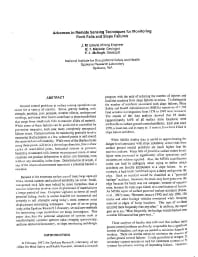Mining Publication: Advances in Remote Sensing Techniques for Monitoring Rock Falls and Slope Failures
Original creation date: August 1998
Authors: JM Girard, RT Mayerle, EL McHugh
NIOSHTIC2 Number: 20000186
Proc 17th Intl Conference on Ground Control in Mining, 1998 Aug :326-331
Ground control problems at surface mining operations can occur for a variety of reasons. Stress, gravity loading, rock strength, geology, pore pressure, weather effects, underground workings, and many other factors contribute to slope instabilities that range from small rock falls to massive slides of material. While some of these failures can be predicted or controlled by preventive measures, each year many completely unexpected failures occur. Current methods for monitoring generally involve measuring displacements at a few, selected points in and around the suspected area of instability. While most of the displacements along these points will be in a downslope direction, freeze-thaw cycles of water-filled joints, horizontal stresses or pressure, buoyancy in saturated soils, human measurement errors, or other situations can produce deformation in almost any direction, even without any instability in a slope. Determination of which, if any of the observed movements represents a potential hazard is essential. Because of the enormous surface area of many large open-pit mines, several varieties and scales of instability can occur. Small, unexpected rock falls may indeed be more hazardous than a massive failure that involves slow displacement of material over a longer period of time. Complete vigilance to detect all small potential falling blocks is neither feasible nor economical and certainly is not attainable using today's most common point displacement monitoring techniques. As part of an on-going study at the Spokane Research Laboratory, several new methods for monitoring slope instabilities are being investigated. This paper describes the potential adaption of systems such as interferometric synthetic aperture radar, imaging spectroscopy, and time-domain reflectometry, to slope monitoring and design.

NIOSHTIC2 Number: 20000186
Proc 17th Intl Conference on Ground Control in Mining, 1998 Aug :326-331
- Analysis of Safety Aspects and Mining Practices for Effective Ground Control in Surface Mining
- Applications of Ground-Based Radar to Mine Slope Monitoring
- Applications of Ground-Based Radar to Mine Slope Monitoring
- Assessing and Monitoring Open Pit Mine Highwalls
- Assessment of Ground Conditions Near a Mine Portal Using Ground Penetrating Radar
- Current Research on Slope Movement in Mines: Use of Hyperspectral Imagery
- Detecting Problems With Mine Slope Stability
- Evaluating Techniques for Monitoring Rock Falls and Slope Stability
- Preventing Injuries Caused by Unrecognized Stone Mine Roof Beam Failures With a Pro-Active Roof Control Plan
- Technology News 506 - The Sky is Falling!: NIOSH Releases Safety Video for Surface Mining Operations